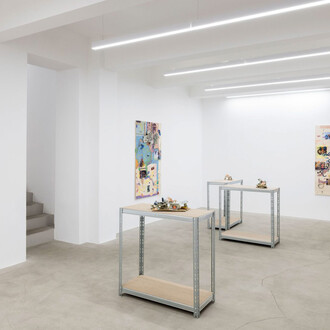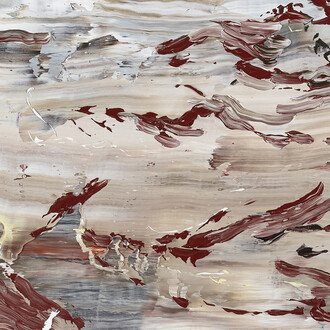Space melts like sand running through one’s fingers. Time bears it away and leaves me only shapeless shreds.”
kaufmann repetto is pleased to announce Days of inertia, Nina Canell’s second solo show with the gallery in Milan.
Days of inertia is both the title of the exhibition and the title of a new sculpture that connects the interior with the exterior of the gallery, spilling out onto the courtyard and into the world. Held in place by hydrophobic barriers, the bulging surface tension traces an archipelago of rocks, leaving a fractured body of water behind. Canell sourced the Arabescato Orobico rocks locally from the nearby Lombard mountain range, a limestone marble whose origins can be traced back to the clear waters and coral reefs of the Triassic. Cut open, like double-page spreads, the exposed rocks spell their histories in lines and layers – awash with the water, light and weather of the tense present. Like so much of Canell’s work, Days of inertia (2025) contains both the micro-phenomenological within as much as the atmospheric conditions of its surroundings. Random dust, debris or pollen may gather on its surface, just as the work is under the constant influence of condensation, evaporation and interference patterns from ambient vibrations.
At the back of the gallery, a congregation of river stones murmur along a curved mechanical belt. Their movement is bent on arbitrary trajectories – Murmur (2025) is a rally for the random and unpredictable. Contrary to how a conveyor is engineered to continuously spew forth bits and bobs of seamless matter, Canell delivers cacophony and countermovement. An erratic rock can be a spanner in the works, an object of signature protest, or a generative actor that brings about a total breakthrough. The insistence on pushing against the outlines of visibility, towards the indeterminacy of forms in relation, persists in the work Pistachio Pangolin on the Continuous fingernail transmitter (2020). Its ‘music of detrition’ cuts vertically across the room, resonating a capella, here separated from a group of improvised sculptures that Canell has often modified and ‘tuned’ site-specifically over the past years. Knotted into the architecture of any given room, vibration itself articulates the underlying vibratory force of all things solid.
At the end of the day, Nina Canell invites us to consider yet another liquid form – that of the rational bubble trapped inside a spirit level. An indicator of stability, the bubble itself is paradoxically in flux, an empty space around which liquid constantly rearranges itself in relation to, and in defiance of. However, the segmented spirit levels of Bubble cult (Porta) (2025) form an arch, an opening – a doorway instead of a checkpoint – a portal suggesting transience and possibility, rather than closure and control. Behind the wall at Via di Porta Tenaglia 7, there is a courtyard hidden behind a ghost door.
Enter.
Nina Canell’s work is variable, durational, and open-ended, grounded in a practice that considers the shared capacity of all materials to transform and overlap beyond the spatio-temporal parameters of an exhibition. Her work has been exhibited in exhibitions and biennales worldwide. Her solo exhibitions include Simian, Copenhagen; OGR, Turin; The Artist’s Institute, New York City; Moderna Museet, Stockholm; Hamburger Bahnhof, Berlin; Camden Arts Centre, London; Mumok, Vienna; Kunsthalle Fridericianum, Kassel, Arko Art Center, Seoul; S.M.A.K., Ghent; and Kunstmuseum St.Gallen, St.Gallen. Canell has participated in the Venice, Sydney, Gwangju, Lyon, Liverpool, Cuenca and Manifesta biennials as well as in major exhibitions at MoMA, New York City; Mori Art Museum, Tokyo; Palais de Tokyo, Paris; Museo Tamayo, Mexico City, and the Guggenheim Bilbao. Canell frequently collaborates with Robin Watkins on installations and artist’s books.
















